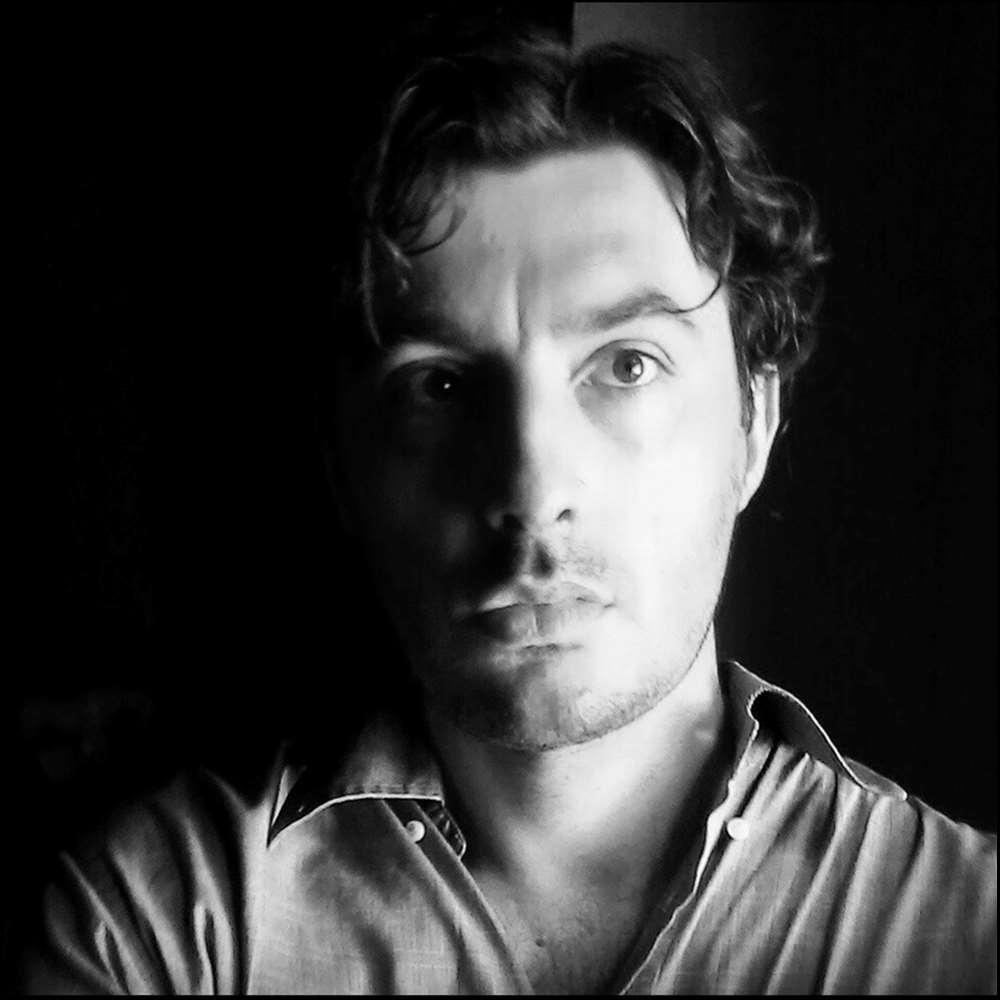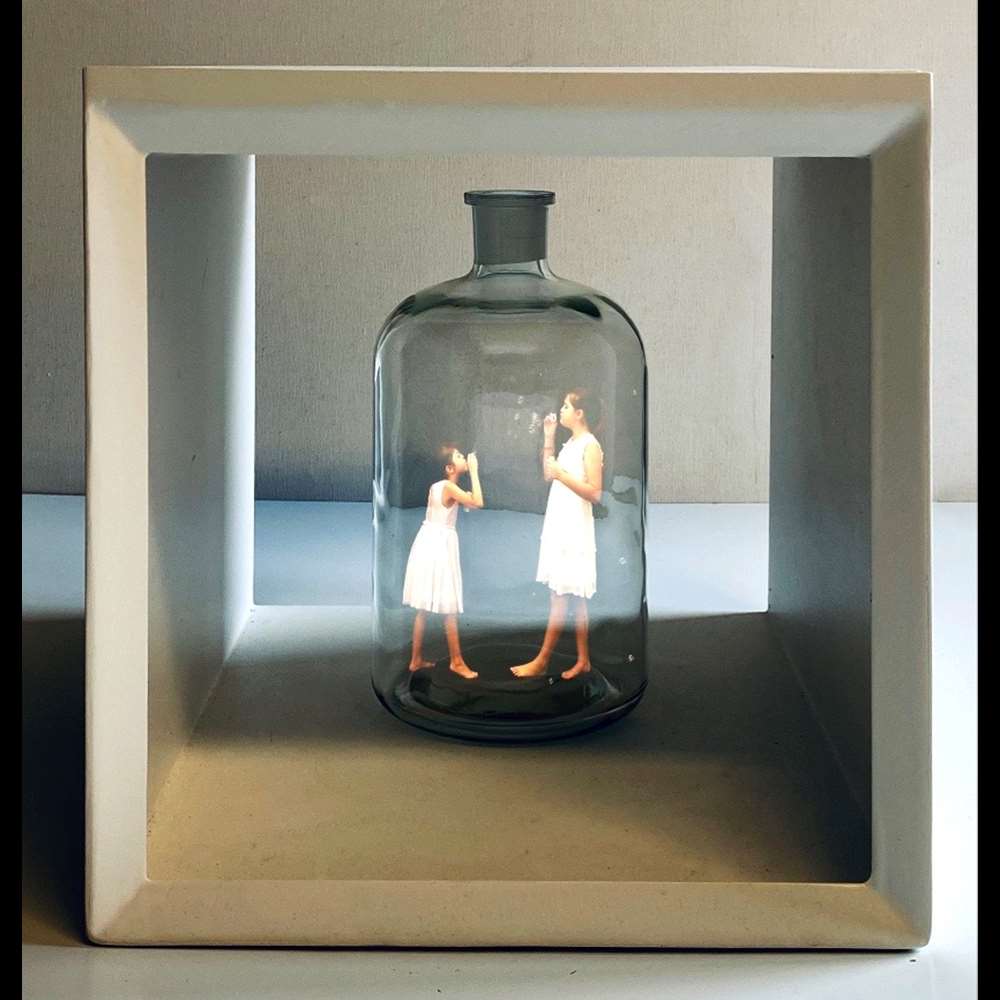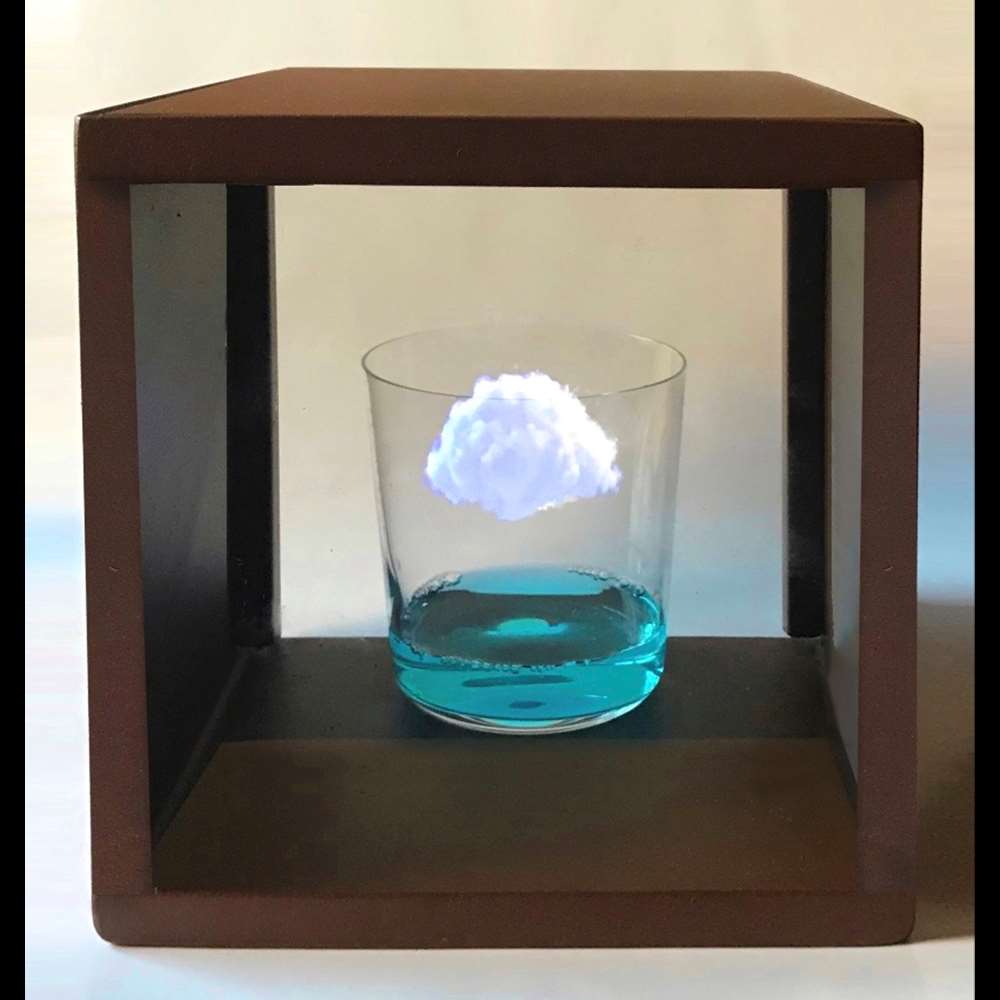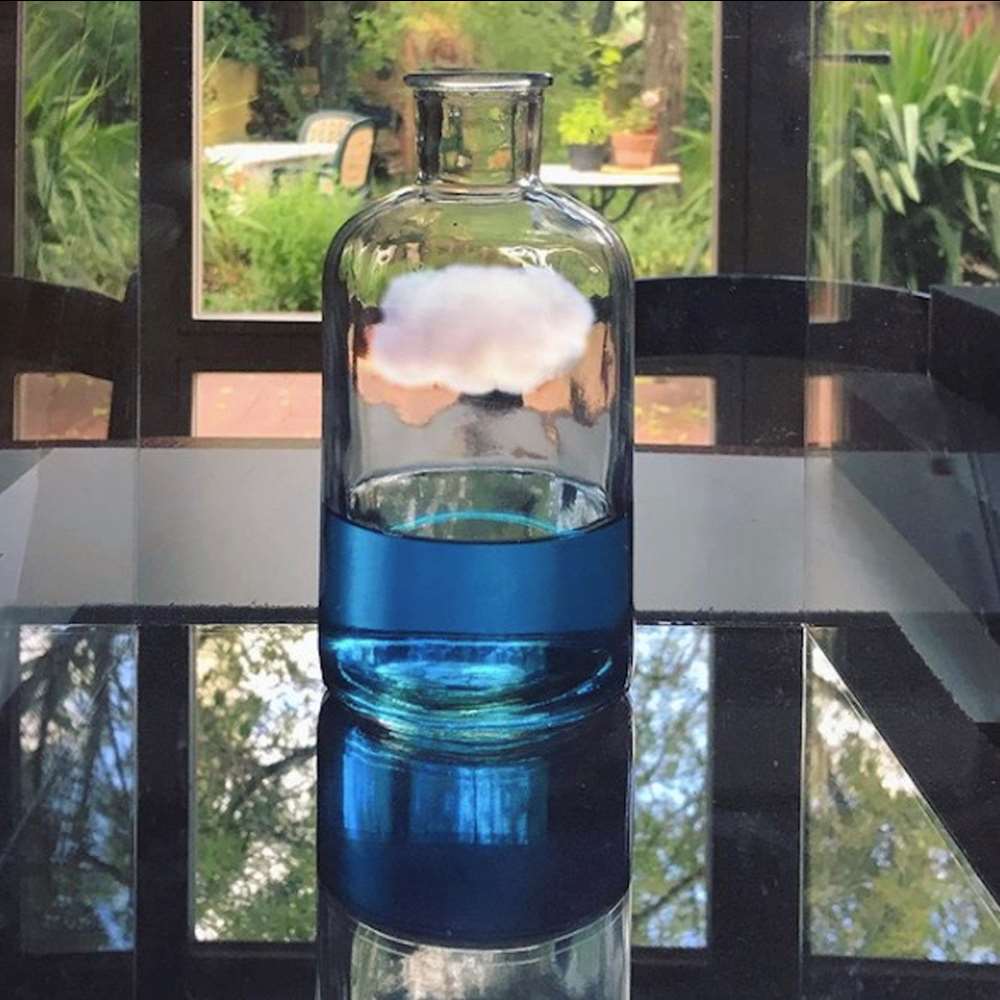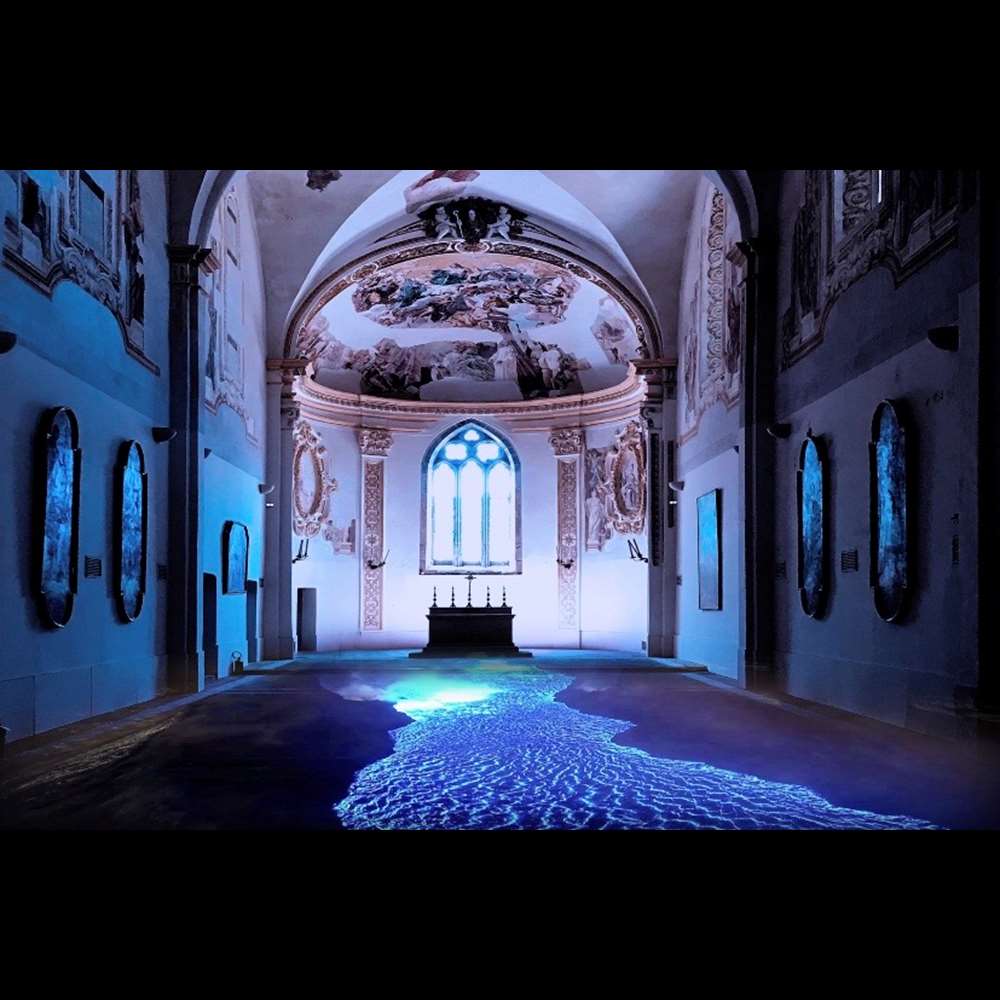-
Interview
What are the foundations of your research (Art Identity)?
I have always tried to make the digital and technological aspect dialogue with reality, using for my holograms commonly used objects such as bottles or jars, now considered almost vintage, and in the case of interactive video installations, putting the work in direct relation with viewers. Holographic perspective is a fairly new language at least in art. Mine is a visual reinterpretation of Bohm's holographic theory: our brains mathematically construct "concrete" reality, interpreting frequencies from another dimension, a dimension of primary structured and meaningful reality that transcends space/time. The brain is a hologram that interprets a holographic universe and our universe is in my case a glass bottle or jar. Gestalt laws help us explain our visual perception because we perceive objects inside the bottle when they are actually outside the bottle.
The interaction serves to bring the general public even the non-experts closer to my works, it calls them to direct participation, they become part of it, indeed without them the work does not exist, it breaks the wall that divides contemporary art from ordinary people, it brings the public closer and at the same time perhaps distances the critic who claims to explain to us what to see in a work.
Who are the artists who have guided you in your research?
I have always followed with interest the artistic research of Bill Viola who was a pioneer or perhaps even "the pioneer" of video art, I really appreciate the installations of Tuscan Massimo Bartolini like me. Looking further east, I would say that I find the Studio Lab artistic group very interesting, one of the most avant-garde in video installations, especially the interactive ones.
Define yourself as a human being using three adjectives.
Irrepressible, herubiscent and edàce
According to your vision, where is contemporary art going and where would you like it to go?
From what I see between museums and art fairs in Italy and abroad, the time required to create a work is always shorter, except in rare cases, and the quality certainly does not help. Thinking of taking, for example, six months to produce a single work unless it is of a monumental nature is almost impossible, obviously I am referring to the activity of professional artists.
From a geographical point of view, I think the emphasis should be placed on countries such as China and India which, also thanks to the economic development of the last few decades, include an increasingly rich panorama of high-profile artists.
Another question I often ask myself is where will contemporary works end up in the future, these large installations that occupy entire rooms of museums or foundations…
Perhaps they will be converted into NFTs and then disposed of, it is unthinkable to have such large warehouses to contain them, poor posterity, we will already leave them a super polluted planet, even large conceptual installations would be better avoided.
Maybe putting an expiration date on large installations would be more environmentally friendly.
As far as Italy is concerned, many Italian contemporary art museums are greatly influenced by the most important galleries which often use them as a luxury deposit to launch or re-launch their artists, maneuvers therefore of a purely commercial nature. I could cite several museum entities that use this modus operandi but it wouldn't be kind... Instead I want to cite an exception that confirms the rule which is the Mambo of Bologna directed by Lorenzo Balbi whom I don't know personally. Every time I've been lucky enough to visit the Bolognese Museum, I've been amazed by the originality and quality of the exhibition project.
From what I see between museums and art fairs in Italy and abroad, the time required to create a work is always shorter, except in rare cases, and the quality certainly does not help. Thinking of taking, for example, six months to produce a single work unless it is of a monumental nature is almost impossible, obviously I am referring to the activity of professional artists.
From a geographical point of view, I think the emphasis should be placed on countries such as China and India which, also thanks to the economic development of the last few decades, include an increasingly rich panorama of high-profile artists.
Another question I often ask myself is where will contemporary works end up in the future, these large installations that occupy entire rooms of museums or foundations…
Perhaps they will be converted into NFTs and then disposed of, it is unthinkable to have such large warehouses to contain them, poor posterity, we will already leave them a super polluted planet, even large conceptual installations would be better avoided.
Maybe putting an expiration date on large installations would be more environmentally friendly.
As far as Italy is concerned, many Italian contemporary art museums are greatly influenced by the most important galleries which often use them as a luxury deposit to launch or re-launch their artists, maneuvers therefore of a purely commercial nature. I could cite several museum entities that use this modus operandi but it wouldn't be kind... Instead I want to cite an exception that confirms the rule which is the Mambo of Bologna directed by Lorenzo Balbi whom I don't know personally. Every time I've been lucky enough to visit the Bolognese Museum, I've been amazed by the originality and quality of the exhibition project.
TWO WORDS ABOUT HIS WORKS
Michelangelo Bastiani Florentine artist, he graduated from the Art Institute of Florence and graduated from the Academy of Fine Arts in Florence, in the painting and photography section with the master Gustavo Giulietti. Bastiani lived in California and New York before returning to Tuscany, and had critically acclaimed exhibitions in major Italian cities and abroad in Paris, Mexico City, Sao Paulo, London, Munich, Istanbul, Frankfurt, Kiev and Oslo. In the United States Bastiani has exhibited in New York, Miami, Palm Beach, the Hamptons, Boca Raton, Houston, Austin, Dallas.
He has also exhibited at the Saatchi Gallery in London and at the Mana Contemporary Museum
of Jersey City.
Michelangelo Bastiani's works are video installations on large screens, interactive video projections and holograms, focused in particular on the elements of nature and the state of matter. Based on Bohm's oleographic theory that "our universe is a gigantic and beautifully detailed hologram", Bastiani's works reproduce a microcosm in a bottle, where the two-dimensional videos
by nature, they become solid and dynamic realities.
The comparison between artifice and nature is a central theme in the history of art: painters, sculptors and architects over the centuries have recreated the world through the lens of their works, Michelangelo Bastiani accepts this challenge by regenerating the natural world in the most recent digital mechanisms, A futuristic process of art, which combines multimedia and real objects, where the work of art becomes a place of interactive cultural animation
